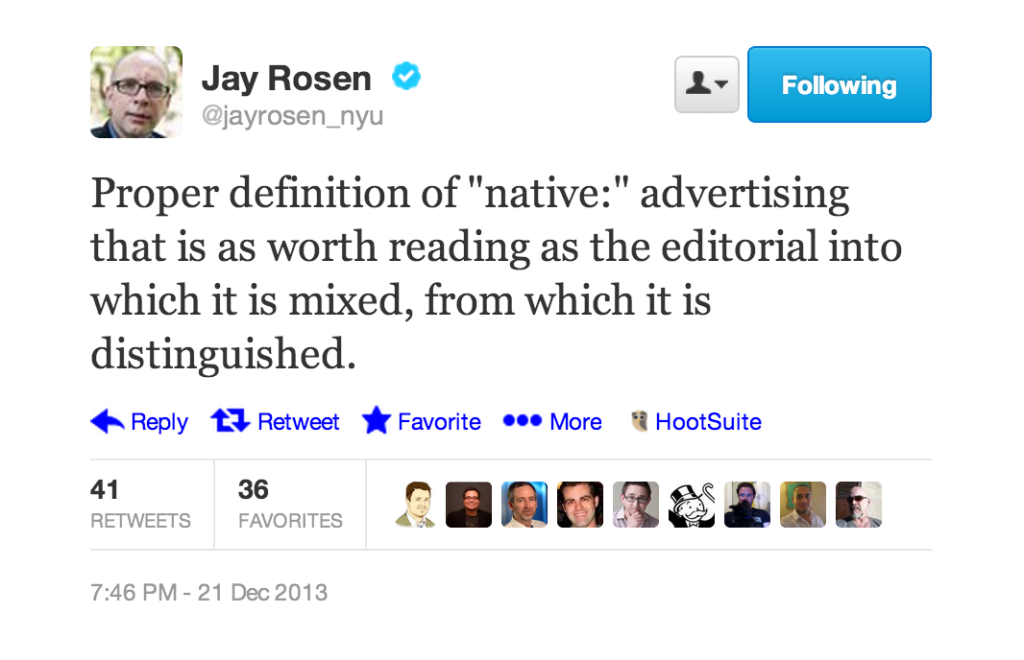Brands
‘Ads That Can Compete With the Best Material Out There’: An Interview With Jay Rosen on the Future of Native
A few days before Christmas, one of the smartest minds in journalism tweeted one of the most intriguing definitions of native advertising we’ve seen.
Rosen, a renowned NYU journalism professor and author of the PressThink blog, sparked a lively debate with the tweet. Things got particularly scrappy with Jeff Jarvis.
To Rosen, whether native advertising succeeds or fails hinges on quality; for a piece of brand publishing to even be properly native to a publication, it has to be just as worth reading as the editorial that surrounds it. A leading voice in the public journalism movement, Rosen sat down with the Strategist in his first interview on native advertising to discuss why he supports brands creating informative, high-quality content.
Jay Rosen on native advertising and content marketing
What is your take on what’s called native advertising and sponsored content?
There’s only one thing. I started thinking about this a few years ago when Lewis Dworkin of Forbes explained BrandVoice to me.
He first explained the contributors section to Forbes in which people with domain expertise are able to become Forbes writers and post what they think is good and Forbes gives them a lot of data. And thousands of contributors are now in this network. And then he explained that they wanted to take the next step in monetizing that network by allowing companies to become contributors for a fee. And then he said that they would just have to compete against everything else Forbes publishes: to get links and shares and move up and spread via social media.
That, I thought, is an idea.
Because if they were going to compete, their articles had to be good and worth reading. If brands just publish press releases, that’s not going to work. It produces a test. Brands now have to produce material actually worth reading and compete with everything else on the web. It undercuts typical PR, the hype of advertising and the type of dramatically inflated claims you see in advertising. That just won’t work.
In which ways do “sponsored content” and native advertising change the media business?
Serious journalism always has been and is subsidized by something. Every subsidy system has traps and we have to continuously examine them.
People keep saying: “There’s nothing new about this.” But this is a kind of ad that can compete with the best material out there. That is different from advertorials.
The biggest challenge for companies is they don’t have people who can do that, and they aren’t used to doing it, either.
What do you think about companies hiring journalists to work in-house and discover stories?
A promising perspective is that they’re letting people who know about stuff talk more freely—engineers or scientists, highly-skilled people.
It reminds me of Robert Scoble. I got interested in him when he was a blogger for Microsoft, paid by Microsoft. He helped teach the company that it had to respond to things and be more open—part of the online conversation. And he wasn’t perfect. And it wasn’t like he could say anything. He was always an employee.
You emphasize the importance of being forthcoming with your biases and point of view. You talk about how the reader trust is gained with transparency. What can brands and advertisers learn from this?
I think if the advertisers are smart they will insist on clear differentiation because that insists on the quality being good, maybe better. When you see advertisers blur the lines, that could be interpreted as lack of confidence in their own material.
Think about Sunday morning political talk shows: For Boeing it’s about associating themselves with communal values that go way beyond the responsibilities of Boeing. So there’s still a large amount of mystification because large companies want to associate themselves with non-business values.
But if the Dvorkin BrandVoice test is real and actually works, then it is smarter for companies to address us with their actual priorities. So it just should be extremely clear what is paid for. Everything that tries to trick the reader is bullshit from my POV.
Then can sponsored content coexist with journalism about the same companies? Say, at The New York Times or WSJ?
We have Dell speaking in a paid post in The New York Times and then we have the technology writers at The New York Times who still have to cover Dell. And I don’t think there’s anything new about that situation.
In other words, it’s not any different than reporters covering advertisers in The New York Times. Sometimes it happens well, sometimes it doesn’t. The pressure would be the same.
Who are the people asking questions of these companies that they don’t want to answer? We shouldn’t expect sponsored content or anything like it to meet that. The duty of the journalist, who does not have a relationship to Dell, in asking questions about Dell is the same.
So it’s not so much whether Dell needs The New York Times to announce something or share information. If they want to share on their channels, they can do that. It’s more that The New York Times still has a lot of muscle and power and influence. So when it covers Dell, that matters to Dell.
The media has undergone so many shifts just in the last few years. Where does native advertising fit in?
There’s a new balance of power. It’s clear advertisers have more power relative to the newsrooms because there are so many more ways to reach people. There’s a search for a new balance of power that both sides can live with.
Whenever I try to understand advertisers, especially newspaper or magazine advertising, I always start with this famous line from John Wanamaker in a previous century: 50 percent of advertising money is wasted but no one can tell me which 50 percent.
That situation began to seem like the natural order of things to people in the ads and publishing business, even though it was simply an uncured defect in the delivery system. Google, among others, started to make progress on that defect. That’s what the Google ad revolution is all about. As it becomes more efficient, it becomes cheaper and as the cost to produce inventory falls, that produces downwards pressure again.
So those things have shifted the balance of power. The whole “sponsored content” struggle is a search for a new equilibrium.
Image by Shutterstock:Get better at your job right now.
Read our monthly newsletter to master content marketing. It’s made for marketers, creators, and everyone in between.






